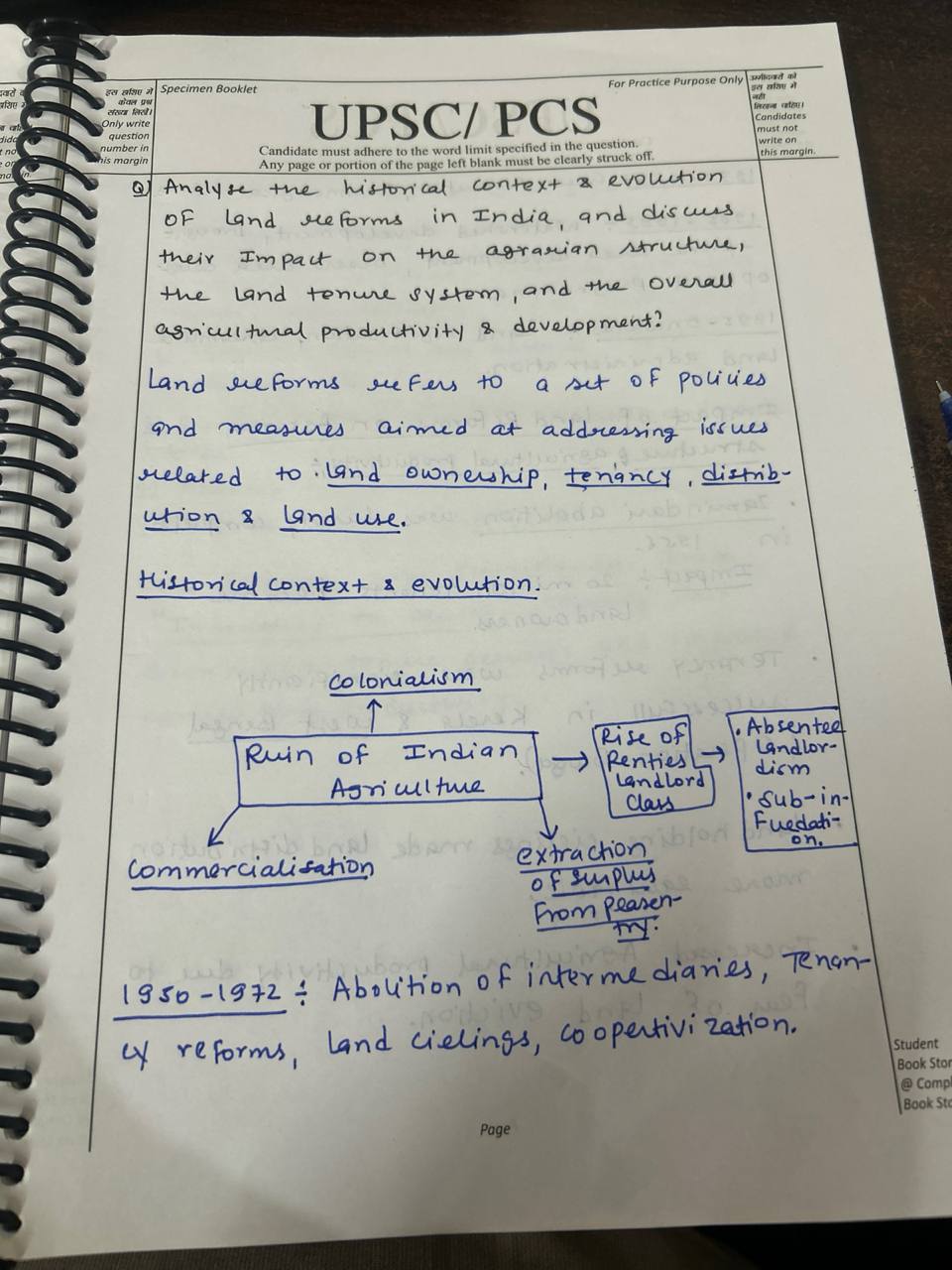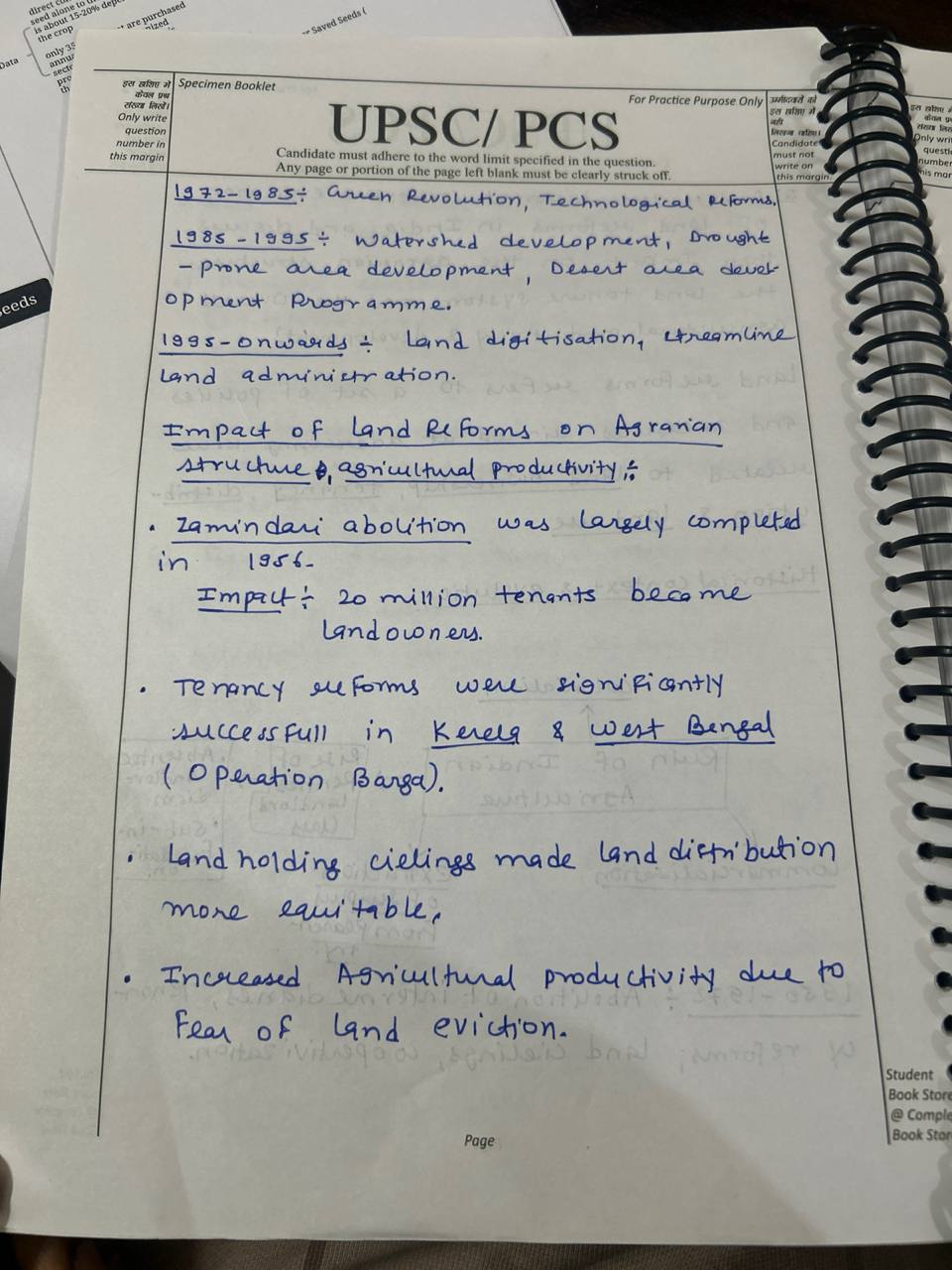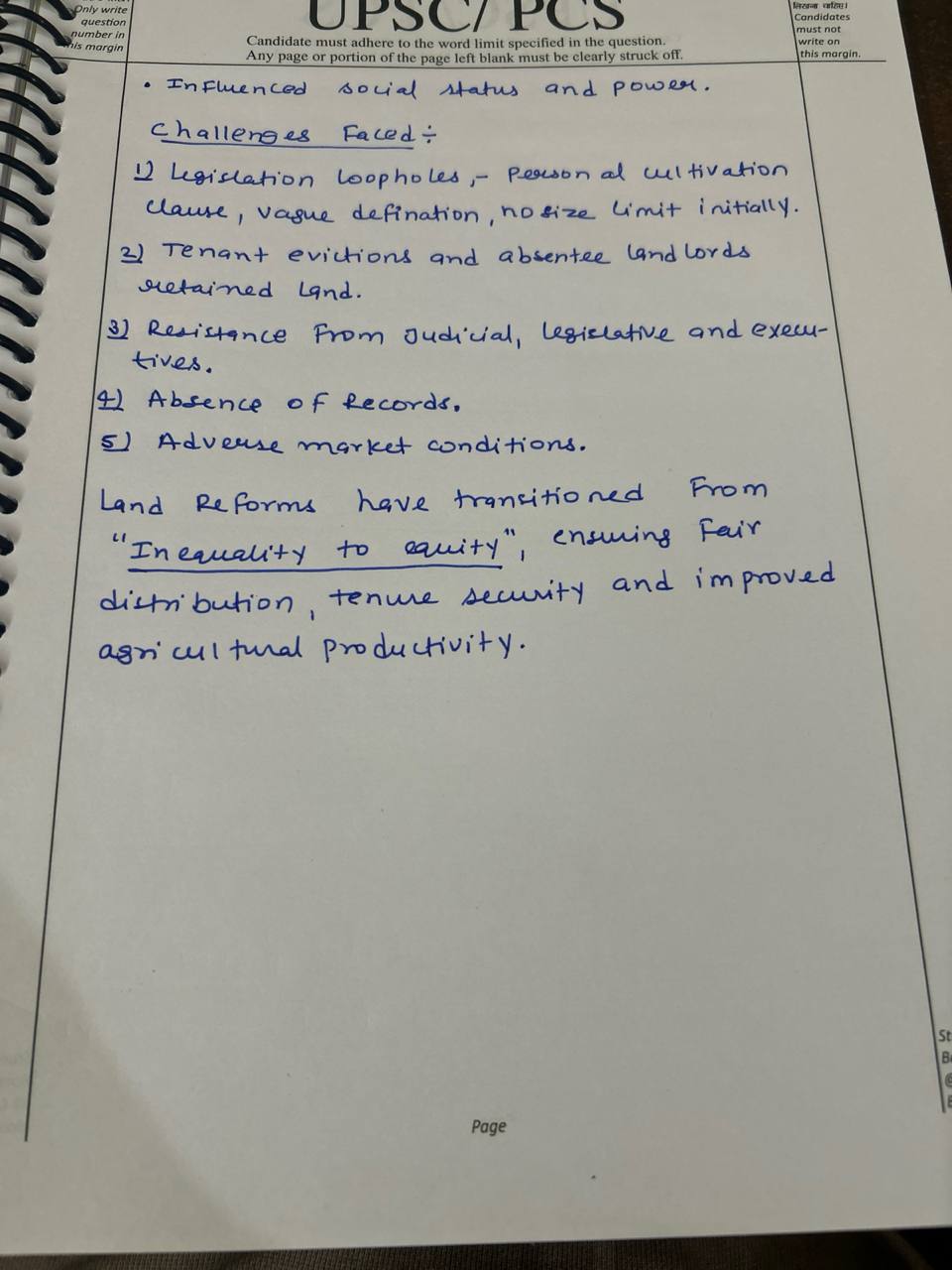Examine how land fragmentation and shifting land-use patterns affect the sustainability and viability of agricultural businesses, especially for small and marginal farmers. Then, talk about the steps that need to be taken to overcome these obstacles.
Assessing the Role of Digitization and Modernization of Land Records 1. Introduction The digitization and modernization of land records, exemplified by initiatives such as the National Land Records Modernization Programme (NLRMP), play a crucial role in enhancing the transparency, accountability, anRead more
Assessing the Role of Digitization and Modernization of Land Records
1. Introduction
The digitization and modernization of land records, exemplified by initiatives such as the National Land Records Modernization Programme (NLRMP), play a crucial role in enhancing the transparency, accountability, and accessibility of land-related information and services. As land records are fundamental for property rights, taxation, and urban planning, their effective management is essential for good governance and economic development. This assessment explores the impact of these initiatives and identifies measures to strengthen their implementation.
2. Impact of Digitization and Modernization
A. Enhancing Transparency
1. Improved Accuracy and Reduction of Disputes: Digitization of land records reduces errors and discrepancies inherent in manual record-keeping. For instance, the Digital India Land Records Modernization Programme (DILRMP), which succeeded the NLRMP, aims to create a unified land record system that reduces inaccuracies and fraud. States like Maharashtra and Rajasthan have reported significant reductions in land disputes due to improved record accuracy.
2. Public Access to Information: Online access to land records increases transparency by allowing citizens to verify land ownership and details. The Bhulekh portal in Uttar Pradesh and the M-Governance app in Tamil Nadu provide public access to land records, enabling stakeholders to view and verify records without relying on physical visits to government offices.
B. Promoting Accountability
1. Streamlined Record Maintenance: Modernized land records systems ensure that updates and changes are systematically recorded and accessible. This helps hold officials accountable for maintaining accurate records. The e-Record Room initiative in Karnataka has streamlined record updates and improved the accountability of revenue officials.
2. Efficient Dispute Resolution: The digital system facilitates quicker and more transparent resolution of land disputes. The Land Revenue Court (LRC) system in Haryana, integrated with digital land records, has expedited the resolution process and increased accountability among land revenue officials.
C. Improving Accessibility
1. Simplified Access to Services: Digitization simplifies the process of accessing land-related services, such as registration and mutation of land. The Single Window Clearance System introduced in Gujarat allows for seamless processing of land-related transactions, reducing bureaucratic delays.
2. Integration with Other Services: Modern land record systems are integrated with other governmental services, such as financial institutions and urban planning agencies. The Integrated Land Information Management System (ILIMS) in Telangana links land records with property taxation and urban planning, enhancing overall accessibility.
3. Measures to Strengthen Initiatives
A. Infrastructure Development
1. Upgrading IT Infrastructure: Robust IT infrastructure is crucial for the effective implementation of digital land record systems. Investment in server infrastructure, cybersecurity, and data backup solutions is essential. The National Informatics Centre (NIC) has been instrumental in supporting infrastructure development across states.
2. Expanding Internet Connectivity: Ensuring widespread internet access is necessary to enable remote access to digital land records. Initiatives like BharatNet aim to provide high-speed internet connectivity to rural areas, thus facilitating broader access to land record services.
B. Capacity Building and Training
1. Training for Officials: Regular training programs for revenue officials and staff are vital for effective use of digital systems. The National Academy of Agricultural Research Management (NAARM) provides specialized training in digital land record management for state officials.
2. Awareness Campaigns for Citizens: Public awareness campaigns are needed to educate citizens about the benefits and use of digital land records. Initiatives like Digital India Week aim to raise awareness and encourage the adoption of digital services.
C. Policy and Regulatory Support
1. Standardization of Data: Developing standardized formats for land records ensures consistency and interoperability across states. The Model Land Records System guidelines issued by the Ministry of Rural Development help states standardize their records.
2. Legal Framework: A strong legal framework is required to address issues such as data privacy and security. The Information Technology Act, 2000, along with amendments, provides a legal basis for the protection of digital records and transactions.
D. Monitoring and Evaluation
1. Performance Evaluation: Regular monitoring and evaluation of the digital land record systems help identify challenges and areas for improvement. The Performance Audit Reports by the Comptroller and Auditor General (CAG) offer insights into the effectiveness of land record modernization initiatives.
2. Feedback Mechanisms: Establishing feedback mechanisms allows users to report issues and suggest improvements. The Grievance Redressal Mechanism in states like Andhra Pradesh provides a platform for users to address concerns and improve service delivery.
4. Conclusion
The digitization and modernization of land records, through initiatives like the NLRMP and DILRMP, significantly enhance the transparency, accountability, and accessibility of land-related information and services. By investing in infrastructure, capacity building, policy support, and effective monitoring, these initiatives can be further strengthened to provide more efficient and reliable land record management, ultimately benefiting both the government and citizens.
See less



Analyzing the Impact of Land Fragmentation and Changing Land-Use Patterns on Agricultural Viability and Sustainability 1. Introduction Land fragmentation and changing land-use patterns significantly impact the viability and sustainability of agricultural enterprises, particularly affecting small andRead more
Analyzing the Impact of Land Fragmentation and Changing Land-Use Patterns on Agricultural Viability and Sustainability
1. Introduction
Land fragmentation and changing land-use patterns significantly impact the viability and sustainability of agricultural enterprises, particularly affecting small and marginal farmers. These issues influence productivity, resource management, and economic viability. This analysis explores these impacts and discusses measures needed to address the challenges posed by these factors.
2. Impact of Land Fragmentation
A. Reduced Operational Efficiency
1. High Costs of Cultivation: Fragmented land holdings often result in higher operational costs due to inefficient use of resources. For example, a study in Uttar Pradesh found that small and marginal farmers with fragmented land had to spend more on irrigation and transportation, reducing their overall profitability.
2. Limited Use of Modern Technology: Small and fragmented farms struggle to adopt modern farming technology and machinery, which requires larger, contiguous land areas. The Punjab government’s experience with the promotion of mechanized farming highlights how land fragmentation limits the adoption of such technology, affecting productivity.
B. Decreased Productivity
1. Inefficient Land Use: Fragmentation leads to inefficient land use, including difficulties in implementing crop rotation and mixed cropping. For instance, Kerala has faced challenges with fragmented holdings affecting the implementation of systematic crop rotation, leading to soil degradation and reduced yields.
2. Soil Degradation: Fragmented lands often face issues like soil erosion and loss of fertility due to inadequate land management practices. Himachal Pradesh, with its small and fragmented holdings, has experienced soil erosion problems impacting agricultural productivity.
C. Increased Vulnerability
1. Exposure to Market Fluctuations: Small, fragmented farms are more vulnerable to market fluctuations and price volatility, affecting their financial stability. Madhya Pradesh has seen small farmers struggling with fluctuating prices due to their inability to scale up production efficiently.
2. Difficulty in Accessing Credit: Fragmented land holdings can hinder access to credit, as financial institutions prefer larger, more stable land holdings for loan approval. The National Bank for Agriculture and Rural Development (NABARD) has identified this as a barrier to agricultural financing for small farmers.
3. Impact of Changing Land-Use Patterns
A. Shift to Non-Agricultural Uses
1. Urbanization and Industrialization: Rapid urbanization and industrialization lead to the conversion of agricultural land for non-agricultural purposes. For instance, Delhi-NCR has experienced significant loss of agricultural land to urban expansion, affecting local food production and increasing the pressure on remaining agricultural land.
2. Loss of Agricultural Land: Changing land-use patterns result in the loss of fertile agricultural land, reducing the area available for farming. Kolkata and its surroundings have witnessed a reduction in agricultural land due to urban sprawl, impacting local food security.
B. Impact on Agricultural Sustainability
1. Resource Depletion: Intensive land use for non-agricultural purposes can lead to depletion of natural resources. In Maharashtra, the shift to industrial use in rural areas has resulted in groundwater depletion, affecting nearby agricultural activities.
2. Biodiversity Loss: Changing land-use patterns can lead to a loss of biodiversity, which impacts agricultural sustainability. Uttarakhand has seen declines in native species due to changes in land use, affecting ecosystem services that support agriculture.
4. Measures to Address These Challenges
A. Land Consolidation and Management
1. Implementing Land Consolidation Programs: Consolidating fragmented land holdings can improve efficiency and productivity. The Uttar Pradesh Land Consolidation Scheme aims to reorganize fragmented lands, making it easier for farmers to adopt modern practices and technologies.
2. Promoting Cooperative Farming: Encouraging cooperative farming models can help small farmers pool resources and share technology. The Amul cooperative model in Gujarat has shown how cooperative farming can enhance productivity and sustainability.
B. Sustainable Land-Use Planning
1. Zoning and Land-Use Regulation: Implementing zoning regulations can help manage urban expansion and protect agricultural land. The National Capital Region Planning Board (NCRPB) has developed land-use plans to control urban sprawl and protect agricultural areas in the Delhi-NCR region.
2. Supporting Sustainable Practices: Promoting sustainable agricultural practices, such as agroforestry and organic farming, can help mitigate the effects of land-use changes. The Himachal Pradesh Organic Farming Policy supports sustainable practices to maintain soil health and productivity.
C. Financial and Technical Support
1. Access to Credit and Insurance: Improving access to credit and insurance for small and marginal farmers can enhance their resilience. The Pradhan Mantri Fasal Bima Yojana (PMFBY) provides crop insurance to protect farmers against losses due to adverse conditions.
2. Technical Training and Extension Services: Providing technical training and extension services helps farmers adapt to changing conditions. The National Agricultural Extension Services Project (NAESP) offers training and support to farmers for adopting modern and sustainable practices.
D. Policy Reforms
1. Revising Land Tenure Policies: Revising land tenure policies to secure land rights and promote efficient land use can support agricultural sustainability. The Model Agricultural Land Leasing Act, 2016, aims to provide a legal framework for land leasing, enhancing land utilization.
2. Encouraging Multi-Use Land Policies: Developing policies that balance agricultural and non-agricultural land uses can help maintain agricultural viability. Kerala’s land-use policies aim to integrate agricultural and developmental needs, ensuring sustainable land management.
5. Conclusion
Land fragmentation and changing land-use patterns present significant challenges to the viability and sustainability of agricultural enterprises, especially for small and marginal farmers. Addressing these challenges requires a multifaceted approach, including land consolidation, sustainable land-use planning, financial support, and policy reforms. By implementing these measures, it is possible to enhance agricultural productivity, ensure resource sustainability, and support the economic well-being of farmers.
See less